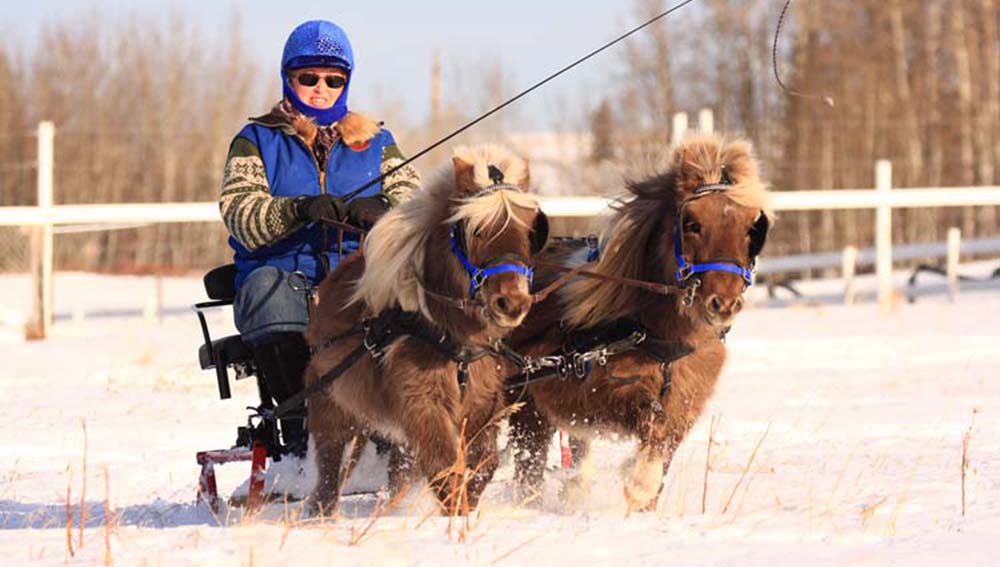
by Kendra Gale
It is recommended to closely monitor your horse’s body condition so you can catch any required changes to your feeding program early and make adjustments before your horse becomes too fat or too thin. Miniature Horses present their owner with a unique challenge—as compared to their larger counterparts—and that is their winter hair.
Miniatures grow a very impressive winter coat, and they grow it early and keep it late, often even in climates where such a thick coat isn’t necessary for warmth. This “fur” is a great asset for keeping them warm, but it can hide a multitude of “sins,” so it is important during the winter months to actually put your hands on your horse on a regular basis to monitor his body condition. If you rely on a visual assessment, you might miss some serious issues that will need attention.
Weanlings, especially, grow a very thick wooly coat, and they are among the most vulnerable to losing weight during their first winter. Elderly horses, as well, should be carefully monitored, but any horse can have a health or dental issue and suddenly lose weight, so feeling routinely for fat cover over ribs, hips, and backbone is very important for the winter health of your horse.
Feeding Naturally in an Unnatural Environment
So what can you do to help your horse stay healthy and happy? It’s a bit of a quandary—you need to give him the nutrition he needs, but not allow him to get overweight, as this comes with its own health risks.
If your management system allows it, divide the same amount of feed into more meals (three or four instead of two). This lets the horse spend more of his day eating and less time fasting.
Remember, it’s during that fasting time that not only is he at an increased risk of gastric ulcers but more likely to develop stereotypical behaviors such as cribbing and windsucking (chewing on fences, and biting onto objects and gulping air into their bellies—a vice that can have serious health consequences).
A slow-feed net is a great tool you can use to help simulate that natural grazing experience. Slow-feed nets have small openings in the mesh, and instead of just being able to eat mouthful after mouthful of hay, the horse has to work each piece through the holes first. A variety of brands are available with different mesh sizes. A three-quarter-inch net is a good starting point, but some Miniatures may need to go to a half-inch net to really slow their eating down.
While it is recommended to initially provide your horse with loose hay in addition to using a net, horses usually adapt very quickly to it and tend to enjoy the challenge. You can get slow-feed nets in every size, from one feeding all the way up to a full round bale. The round-bale nets have the added benefits of virtually eliminating the usual wastage that occurs with traditional round-bale feeders, and greatly reduces the health concerns, which are an increased risk of heaves from inhaling the dust inside the bale, and eye injuries, again from horses standing with their head inside the bale while they eat.
Water—In All Weather
Water and forage are the two most critical elements to keep your horse healthy and happy. Horses need to have unlimited access to water to keep their digestive tract working properly. The number one killer of horses is colic, and lack of hydration can be a major contributor.
Encouraging your horse to drink in extreme cold and extreme heat is especially important. During the winter, it is very important to understand that horses cannot get enough fluid from eating snow, and must always have access to fresh, thawed water. If you are in a climate where you routinely get below-freezing temperatures, investing in a heated bucket, stock-tank heater, or automatically heated waterer is not only be beneficial for your horse’s health, it makes your winter chores much less painful—no one likes spending time outside breaking ice.
When it’s cold, horses drink more if their water is warm, while in hot weather, cool water encourages them to increase their intake. Keeping their water in a shady spot, or adding ice to the pail can help encourage your horse to stay hydrated in the heat.
Temperature swings can lead to an increased incidence of colic, and reduced water intake is likely a key factor. Everything you can do to encourage your horse to drink is going to be beneficial to his health.
This excerpt from The Big Book of Miniature Horses by Kendra Gale is reprinted with permission from Trafalgar Square Books (www.horseandriderbooks.com).
Get all kinds of information about caring for your horse in our section on Health & Education.

































